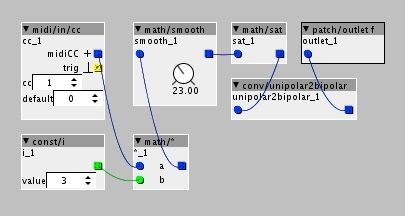the question is why do you think that...
the reason is, you believe (incorrect  ) that the execution order is determined by the wires.
) that the execution order is determined by the wires.
i.e. you viewing data flowing down the wires, like electricity...
and thats the fundamental issue, it doesn't actually work like that... in some ways the 'metaphor' breaks down.
(there are other posts about why this is like it is, and how we can improve)
no... the way to think about it is a bit different.
every object is executed in turn, and 'presents' its data at the outlets, for connected inlets to pick up when they get executed.
so when is an object executed, well left to right, top to bottom ... or in 'reading order' (for the western world)
so in your example this means...
the CC object makes it data available to the multiply (good), the smooth object takes it data from the multiply BUT the multiply has not yet executed, so what value is that? well the value the multiply calculated on the last execution cycle.. (since its not run for this one yet)
its simple when you understand this, but can be counter intuitive.
why not follow the wires... well thats not always clear either. (again see other discussions)
and is why (partly) why max and reaktor have 'trigger'(order in reaktor) objects, which allow the user to influence the execution order. (ok its slightly different as max/reaktor are event based, which axoloti is not, and thats a completely different subject  )
)
I will say, looking in the user guide, this is perhaps not clear enough, and an example would help alot....
actually, do you mind if I use your picture as an example, as I can then perhaps use my explanation, as a good example?
(as I said, we all go through this, you are not alone  )
)

 )
)


